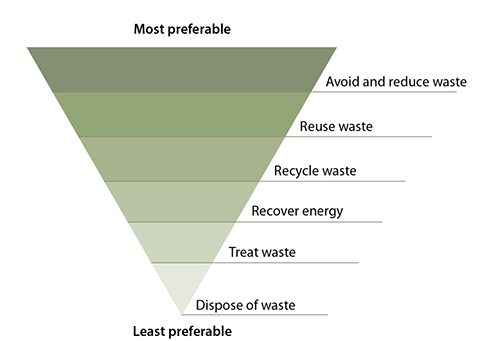The waste hierarchy is:
- avoidance including action to reduce the amount of waste generated by households, industry and all levels of government
- resource recovery including re-use, recycling, reprocessing and energy recovery, consistent with the most efficient use of the recovered resources
- disposal including management of all disposal options in the most environmentally responsible manner.

Avoiding and reducing waste
The highest priority, avoiding and reducing the generation of waste, encourages the community, industry and government to reduce the amount of virgin materials extracted and used. The goal is to maximise efficiency and avoid unnecessary consumption through behaviours such as:
- selecting items with the least packaging or that require the fewest resources to produce
- avoiding disposable goods or single-use materials
- buying products that are re-usable, repairable, refillable, recycled or recyclable
- using leftover food rather than throwing it away.
Recovering resources
The second priority, resource recovery, maximises options for re-use, recycling, reprocessing and energy recovery.
Where avoiding and reducing waste is not possible, the next most preferred option is to re-use the materials without further processing, avoiding the costs of energy and other resources required for recycling. For example, many household and industrial items can be repaired, re-used, sold or donated to charities.
Re-use (without further processing) and recycling (processing waste materials to make the same or different products) keeps materials in the productive economy and benefits the environment by decreasing the need for new materials and waste absorption.
Where further recycling is not feasible, it may be possible to recover the energy from the material and feed that back into the economy where this is acceptable to the community.
Some materials may be inappropriate to re-use, recycle or recover for energy and instead require treatment to stabilise them and minimise their environmental or health impacts.
Treatment or disposal
Finally, the waste hierarchy recognises that some types of waste, such as hazardous chemicals or asbestos, cannot be safely recycled and direct treatment or disposal is the most appropriate management option.

